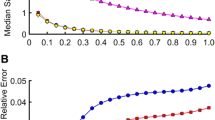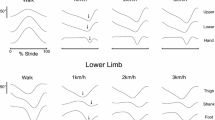Abstract
Linear and angular control of trunk and leg motion during curvilinear navigation was investigated in subjects with cerebellar ataxia and age-matched control subjects. Subjects walked with eyes open around a 1.2-m circle. The relationship of linear to angular motion was quantified by determining the ratios of trunk linear velocity to trunk angular velocity and foot linear position to foot angular position. Errors in walking radius (the ratio of linear to angular motion) also were quantified continuously during the circular walk. Relative variability of linear and angular measures was compared using coefficients of variation (CoV). Patterns of variability were compared using power spectral analysis for the trunk and auto-covariance analysis for the feet. Errors in radius were significantly increased in patients with cerebellar damage as compared to controls. Cerebellar subjects had significantly larger CoV of feet and trunk in angular, but not linear, motion. Control subjects also showed larger CoV in angular compared to linear motion of the feet and trunk. Angular and linear components of stepping differed in that angular, but not linear, foot placement had a negative correlation from one stride to the next. Thus, walking in a circle was associated with more, and a different type of, variability in angular compared to linear motion. Results are consistent with increased difficulty of, and role of the cerebellum in, control of angular trunk and foot motion for curvilinear locomotion.





Similar content being viewed by others
Abbreviations
- ΔLFOOT :
-
Step length
- ΔθFOOT :
-
Change in foot angle between steps
- R FOOT :
-
Foot radius = ΔLFOOT/(2 sin(ΔθFOOT/2))
- VTRUNK :
-
Trunk linear velocity
- ΩTRUNK :
-
Trunk angular velocity
- RTRUNK :
-
Trunk radius = VTRUNK/ΩTRUNK
- CoV:
-
Coefficient of variation
References
Beauchet O, Annweiler C, Lecordroch Y, Allali G, Dubost V, Herrmann FR, Kressig RW (2009) Walking speed-related changes in stride time variability: effects of decreased speed. J Neuroeng Rehabil 6:32
Bendat JS, Piersol AG (2000) Random data: analysis and measurement procedures. Wiley, New York
Courtine G, Schieppati M (2003) Human walking along a curved path. I. Body trajectory, segment orientation and the effect of vision. Euro J Neurosci 18:177–190
Courtine G, Schieppati M (2004) Tuning of a basic coordination pattern constructs straight-ahead and curved walking in humans. J Neurophysiol 91:1524–1535
Courtine G, Papaxanthis C, Schieppati M (2006) Coordinated modulation of locomotor muscle synergies constructs straight-ahead and curvilinear walking in humans. Exp Brain Res 170:320–335
Cumming RG, Klineberg RJ (1994) Fall frequency and characteristics and the risk of hip fractures. J Am Geriatr Soc 42(7):774–778
Dite W, Temple VA (2002) Development of a clinical measure of turning for older adults. Am J Phys Med Rehabil 81:857–866
Duysens J, Duysens JP, Bastiaanse CM, van Sprundel M, Schubert M, Smits-Engelsman BC (2008) How trunk turns affect locomotion when you are not looking where you go. Hum Mov Sci 27(5):759–770
Earhart GM, Melvill Jones G, Horak FB, Block EW, Weber KD, Fletcher WA (2001) Forward versus backward walking: transfer of podokinetic adaptation. J Neurophysiol 86:1666–1670
Earhart GM, Fletcher WA, Horak FB, Block EW, Weber KD, Suchowersky O, Melvill Jones G (2002) Does the cerebellum play a role in podokinetic adaptation? Exp Brain Res 146:538–542
Frenkel-Toledo S, Giladi N, Peretz C, Herman T, Gruendlinger L, Hausdorff JM (2005) Effect of gait speed on gait rhythmicity in Parkinson’s disease: variability of stride time and swing time respond differently. J Neuroeng Rehabil 2:23
Gordon CR, Fletcher WA, Melvill Jones G, Block EW (1995) Adaptive plasticity in the control of locomotor trajectory. Exp Brain Res 102:540–545
Horak FB, Diener HC (1994) Cerebellar control of postural scaling and central set in stance. J Neurophysiol 72:479–493
Kavanagh JJ, Morrison S, Barrett RS (2005) Coordination of head and trunk accelerations during walking. Eur J Appl Physiol 94:468–475
Kuo AD, Donelan JM (2010) Dynamic principles of gait and their clinical implications. Phys Ther 90:157–174
McIlroy WE, Maki BE (1997) Preferred placement of the feet during quiet stance: development of a standardized foot placement for balance testing. Clin Biomech 12:66–70
Melvill Jones G, Fletcher WA, Block EW, Weber KD, Horak FB, Earhart GM (2006) A locomotor system for controlling spatial orientation. Society for Neuroscience Abstract Number 349.16
Morton SM, Bastian AJ (2006) Cerebellar contributions to locomotor adaptations during split belt treadmill walking. J Neurosci 26:9107–9116
Nevitt MC, Cummings SR, Hudes ES (1991) Risk factors for injurious falls: a prospective study. J Gerontol 46:M164–M170
Orendurff MS, Segal AD, Berge JS, Flick KC, Spanier D, Klute GK (2006) The kinematics and kinetics of turning: limb asymmetries associated with walking a circular path. Gait Posture 23:106–111
Osaki Y, Kunin M, Cohen B, Raphan T (2007) Three-dimensional kinematics and dynamics of the foot during walking: a model of central control mechanisms. Exp Brain Res 176:476–496
Paquette C, Melvill Jones G, Horak F (2007) Circular walking in patients with cerebellar ataxia. Society for Neuroscience Abstract Number 411.21
Paquette C, Franzén E, Jones GM, Horak FB (2011) Walking in circles: navigation deficits from Parkinson’s disease but not from cerebellar ataxia. Neuroscience 190:177–183
Reisman DS, Block HJ, Bastian AJ (2005) Interlimb coordination during locomotion: what can be adapted and stored? J Neurophysiol 94:2403–2415
Souman JL, Frissen I, Sreenivasa M, Ernst MO (2009) Walking straight into circles. Curr Biol 19:1538–1542
Stack EL, Ashburn AA, Jupp KE (2006) Strategies used by people with Parkinson’s disease who report difficulty turning. Parkinsonism Rel Disord 12:87–92
Stolze H, Friedrich HJ, Steinauer K, Vieregge P (2000) Stride parameters in healthy young and old women—measurement variability on a simple walkway. Exp Aging Res 26:159–168
Takei Y, Grasso R, Berthoz A (1996) Quantitative analysis of human walking trajectory on a circular path in darkness. Brain Res Bull 40:491–495
Takei Y, Grasso R, Amorim MA, Berthoz A (1997) Circular trajectory formation during blind locomotion: a test for path integration and motor memory. Exp Brain Res 115:361–368
Timmann D, Horak FB (1997) Prediction and set-dependent scaling of early postural responses in cerebellar patients. Brain 120:327–337
Weber KD, Fletcher WA, Gordon CR, Melvill Jones G, Block EW (1998) Motor learning in the “podokinetic” system and its role in spatial orientation during locomotion. Exp Brain Res 120:377–385
Zampieri C, Salarian A, Carlson-Kuhta P, Aminian K, Nutt JG, Horak FB (2010) The instrumented timed up and go test: potential outcome measure for disease modifying therapies in Parkinson’s disease. J Neurol Neurosurg Psychiatr 81:171–176
Zoubir AM, Boashash B (1998) The bootstrap and its application in signal processing. IEEE Signal Proc Mag 15:56–76
Acknowledgments
We would like to thank Triana Nagel for her help with subject recruitment and data collection and reduction. We thank Erika Franzen for helpful discussion regarding this study. Work supported by NIH grant DC004082, R37-Ag006457 and CIHR RMF—79025.
Author information
Authors and Affiliations
Corresponding author
Rights and permissions
About this article
Cite this article
Goodworth, A.D., Paquette, C., Jones, G.M. et al. Linear and angular control of circular walking in healthy older adults and subjects with cerebellar ataxia. Exp Brain Res 219, 151–161 (2012). https://doi.org/10.1007/s00221-012-3074-z
Received:
Accepted:
Published:
Issue Date:
DOI: https://doi.org/10.1007/s00221-012-3074-z




